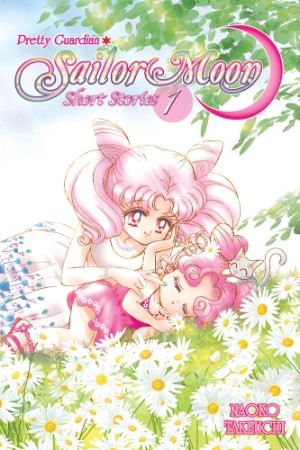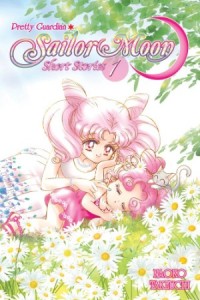By Naoko Takeuchi. Released in Japan as “Bishoujo Senshi Sailor Moon” by Kodansha, serialized in the magazine Run Run. Released in North America by Kodansha Comics.
There’s an important thing to keep in mind when reading this first of two collections of short stories that were interspersed throughout the series’ run: they didn’t run in Nakayoshi. They ran in a sister magazine, run Run, which was also home to Sailor V. Run Run no longer exists today, but I seem to recall when it was around that its core audience was girls about 2-3 years younger than the usual Nakayoshi audience. And that’s not even getting into the fact that these are quick side-stories Naoko dashed off in between chapters, so are naturally going to be a bit more comedic and fluffy than the core plotline.
If all of this sounds a bit defensive, well, let’s just say that ‘light and frothy’ doesn’t begin to describe this volume of Sailor Moon extras, most of which are very silly and not exactly lending themselves to deeper analysis. Four of the stories star Chibi-Usa and her friends (with occasional rescues from Sailors Moon and V), while three others detail the struggles of the Inners to pass high school exams. The first one is around the R continuity (Chibi-Usa has just arrived, and is meeting her very busty friend Momo… Ranma fans will immediately be reminded of Shampoo), but most of the stories take place around the SuperS continuity – indeed, a few of them were adapted into the SuperS anime – with the final one seeming to be around Stars, given it has Hotaru.
This is not to say I did not 100% enjoy these stories, as I did. I like Naoko’s style of blatant humor, and she has a knack for amusing caricature faces. The Chibi-Usa stories at the beginning are pure fun for kids, with the kids getting into danger and having to transform to get themselves out of it. The story at the end is slightly longer and attempts to have more depth, but there’s only so far you can go when you find out that Naru’s sister is not only a kogal but is also named Naruru. It’s good to know that Japan has horrible naming sense as well. (Also, kudos to Mari Morimoto for the translation of this chapter, which was filled with topical Japanese slang that Chibi-Usa and Hotaru pointed out and lampshaded throughout, thus making it virtually unadaptable. A very nice job.)
My favorite part of the book, I will admit, are the three stories focusing on the Inners. Makoto’s is probably the weakest, but we do get some amusing scenes of her procrastination through cooking and housework, and also hear about her late parents for what may be the only time in the manga OR anime canon. (They’re killed in a plane crash when Makoto was a little girl, which is used here as both an amusing gag and to have Mako gain sympathy points from her friends.) Ami’s First Love is probably the best written of the three, and it’s no surprise that the anime adapted this into a short film for theaters. Ami can be very tightly wound, so seeing her coming unglued at finding a student who’s just as perfect in studying as she is is hilarious, particularly when she gets so upset by this she seems to make herself ill.
And then there’s Rei and Minako. I’ve discussed how much I love this chapter before, silly as it is, and that hasn’t changed. The manga version of Rei – cool, collection, a bit ‘ice queen’ – is in such contrast to Minako’s extrovert that it makes sense that she’d want to see what Rei’s life at school is like – and yes, she’d want to ask if Rei farted. I think that Minako regards Rei as a bit too perfect, and this is just her own tactless way of trying to reassure herself that Rei is human after all. Of course, all that her visit to Rei’s perfect Catholic school ends up doing is tweaking Minako’s own insecurities – and that leads to Rei seeming genuinely upset at Minako getting angry, showing she *isn’t* the perfect ice princess. Rei is likely very lonely at that school where she only has admirers, and just can’t express her friendships in the way that Minako wants her to. Still, they manage to bond by… well, Rei being possessed and trying to kiss Minako. And afterwards being crankier than ever. But Minako’s feeling good again, and that’s what’s important. Bless these children.
So if the Sailor Moon series was a full-course meal, then this is dessert. Don’t go into it expecting anything more than delicious sweets that are easy on the eyes but not all that good for you, and you should be fine. Also, Rei has never farted. She is better than all of us.


Rei *is* better than all of us. XD
What I like about these stories is that they show the strong bonds between the Scouts outside of battle. The main series can sometimes feel ALL EPIC ALL THE TIME, so it’s good to see that the characters actually have a reason to fight for and support each other besides the fate of the known universe being at stake. Both Japanese and American media delight in showing us images of teenage girls being catty and terrible to each other, so the stories in this volume were a welcome breath of fresh air. As you mention, the story focusing on Rei and Minako was especially dramatic. It seemed less like fluffy braincandy and more like a fairly serious portrayal of two young women dealing with class differences for the first time and coming out of the experience knowing that they can maintain their camaraderie. The combination of the strong and healthy homosocial friendships and the avoidance of the “teenage girls are bitchy” trope made me feel really good about this collection. I wish I had had access to it when I was younger…